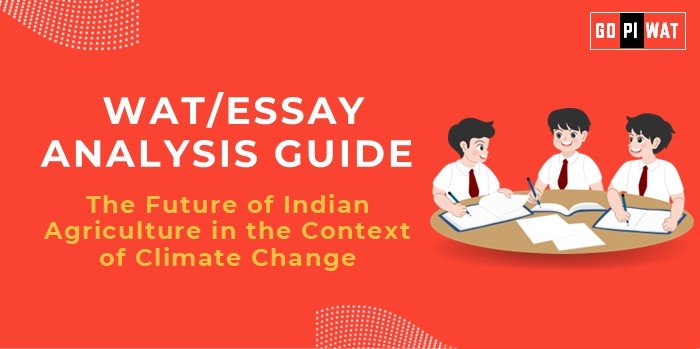📋 WAT/Essay Analysis Guide
🌾 The Future of Indian Agriculture in the Context of Climate Change
🌟 Understanding the Topic’s Importance
Agriculture is vital to India’s food security and economy but is increasingly vulnerable to climate change. This essay allows B-school aspirants to showcase their analytical skills, linking macroeconomic, social, and environmental aspects.
📝 Effective Planning and Writing
- ⏱️ Time Allocation:
- Planning: 5 minutes
- Writing: 20 minutes
- Review: 5 minutes
💡 Introduction Techniques
- Contrast Approach:
- Solution-Oriented Approach:
“While Indian agriculture feeds 1.4 billion people, it remains vulnerable to climate unpredictability, threatening livelihoods and economic stability.”
“Climate-resilient farming can transform Indian agriculture into a sustainable, global leader in food production.”
🔍 Structuring the Essay Body
🏆 Achievements:
- 💸 PM-KISAN: Direct income support to farmers has bolstered financial stability.
- 💧 Micro-Irrigation Initiatives: Programs like PMKSY (Pradhan Mantri Krishi Sinchayee Yojana) enhance water-use efficiency.
- 🌱 Drought-Resistant Seeds: Adoption of climate-resilient crop varieties has improved yields in adverse conditions.
⚠️ Challenges:
- 🚰 Water Scarcity: Over-reliance on groundwater and inefficient irrigation practices exacerbate resource depletion.
- 🚜 Lack of Mechanization: Small landholdings limit the adoption of advanced machinery.
- 📊 Socio-Economic Disparities: Marginalized farmers often lack access to technology and credit facilities.
🔮 Future Outlook:
- 🤖 Agri-Tech Solutions: Leverage remote sensing, IoT, and AI to optimize farming practices.
- 📜 Policy Reforms: Strengthen crop insurance schemes and incentivize sustainable farming practices.
- 🌍 Global Partnerships: Collaborate with nations like the Netherlands for precision farming insights and practices.
📄 Conclusion Templates
- Balanced Perspective:
- Global Comparison:
“Addressing climate challenges in agriculture is a complex but critical task for India. By leveraging technology and inclusive policies, the nation can safeguard its agricultural legacy while securing food security for its growing population.”
“India’s approach to sustainable agriculture can draw lessons from countries like the Netherlands, with its precision farming techniques, while addressing unique challenges such as small farm sizes and resource constraints.”
📝 Sample Short Essays (100 Words)
📌 Balanced Perspective:
“India’s agriculture faces dual challenges of ensuring food security and combating climate change. While initiatives like PM-KISAN and micro-irrigation have made strides, over-reliance on rainfall and limited technology adoption threaten progress. A balanced approach integrating policy support, technology, and community participation is essential for a sustainable future.”
📌 Solution-Oriented:
“The future of Indian agriculture lies in adopting precision farming and sustainable practices. By investing in technologies such as remote sensing and climate-resilient seeds, India can enhance productivity without depleting its natural resources. These strategies, supported by robust government policies, can transform agriculture into a resilient economic pillar.”
📌 Global Comparison:
“India, with its vast agricultural base, has the potential to become a global model for climate-resilient farming. Countries like the Netherlands demonstrate how innovation can drive productivity. India must bridge the gap between innovation and execution, particularly in rural areas, to lead the way in sustainable agriculture.”


